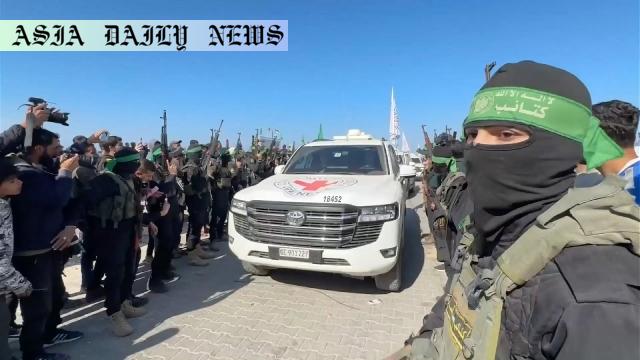Hostages: Hamas releases three more Israeli citizens as part of a six-week ceasefire deal, marking significant progress in peace efforts.
Hamas released three more Israeli hostages under a six-week ceasefire agreement.
Thirteen captives have been freed so far, with 20 to be released in the coming weeks.
Israel exchanged 400 Palestinian prisoners for the hostages.
Five Thai hostages were separately freed outside of the agreement.

Hamas Releases Hostages During Ceasefire
In a significant step towards easing tensions, the Islamic group Hamas has released three additional Israeli hostages as part of a ceasefire agreement with Israel. This brings the total number of captives freed under this deal to 13. The three male civilians who were let go on Saturday are part of a broader plan brokered to promote some semblance of calm between the conflicting parties.
The Ceasefire Agreement: A Negotiated Peace
The six-week ceasefire deal, which began on January 19, holds the key to releasing a total of 33 hostages in carefully structured phases. Hamas earlier freed 10 hostages under the arrangement, which included women and senior citizens. Saturday’s release adds momentum to a fragile yet hopeful process of restoring peace on humanitarian grounds.
An Exchange that Involves Hundreds
It’s not just hostages being freed by Hamas. As part of the agreement, Israel has released a remarkable 400 Palestinian prisoners and detainees. This mutual exchange is a monumental step in addressing decades of animosity, though tensions and mistrust persist. Such deals often take months to materialize due to their highly sensitive and complex nature.
Other Developments Outside the Agreement
Outside the framework of this specific agreement, Hamas also freed five Thai hostages on Thursday. This unexpected gesture underscores the group’s intent to demonstrate flexibility and perhaps strengthen its negotiation stance for future deals.
The Path Ahead for Hostages
While progress has been made, the next few weeks will determine the success of this ceasefire deal. Hamas is set to release 20 additional hostages over a four-week period. Such phased agreements are not without challenges, as circumstances can shift swiftly in volatile regions.
Humanitarian Implications
The release of hostages and prisoners alike reflects a humanitarian approach rarely seen amid conflicts of such scale. Families on both sides are experiencing a mix of relief and anxiety as their loved ones return home. International observers have welcomed this development, calling for further dialogue and sustained peace efforts.
Broader Regional Impacts
These events have also drawn attention to the broader regional dynamics. While this ceasefire demonstrates the possibility of resolutions, deeper political issues remain unaddressed. Until these root causes are engaged with constructively, periods of peace may only be fleeting.
The Importance of Bold Diplomacy
Ultimately, the success of this agreement relies on both sides abiding by the terms set forth. It also emphasizes the transformative power of bold diplomacy. International mediators and neighboring governments are likely continuing conversations behind closed doors to uphold this fragile détente.
Conclusion
The release of hostages and prisoners is a step in the right direction, bringing hope to the affected families and communities. However, sustainable peace will require long-term political solutions beyond such humanitarian exchanges. For now, the world watches closely as Israel and Hamas negotiate through one of the most challenging chapter of their conflict.



Commentary
A Step Toward Humanity
The release of hostages by Hamas marks a moment of relief in the otherwise tense and grim conflict between Israel and Palestine. Such acts remind us of the importance of focusing on humanity even amidst prolonged strife. For the families of those captured, this brings hope and closure that seemed distant just a short while ago. These moments, though small, carry the potential for optimism in the face of despair.
The Ceasefire’s Fragility
While the ceasefire agreement is undoubtedly an achievement, it remains precarious. Both Hamas and Israel have a history of distrust and deep grievances. The promises made under the agreement will need to be implemented diligently to prevent backsliding into violence. The phased nature of hostage releases adds complexity, but it also ensures that dialogue continues, creating further opportunities for building trust.
Lessons for Future Diplomacy
This ceasefire is also a testament to the power of international mediation and proactive diplomacy. While the current deal may not resolve all issues, it sets a precedent for future negotiations. It underscores the critical need for clear communication, mutual concessions, and patience. International actors should capitalize on this progress to push for enduring solutions and not just temporary measures.
A Reminder to Value Peace
In moments like these, it is paramount to remember the cost of conflict. Hostage releases and prisoner exchanges are not just about individuals—they are about the larger message of reconciliation. One can only hope that both sides realize the value of peace over violence and work toward a more stable and harmonious future.